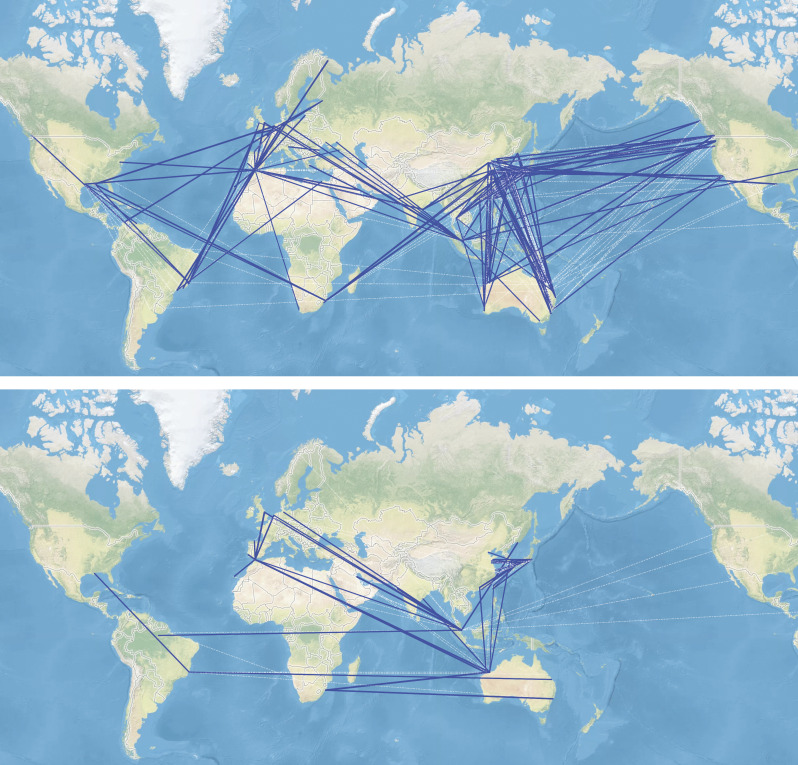Evolution of maritime shipping routes
Comparison of prediction quality of link openings of the common neighbors model (Top) vs. port-gravity model (Bottom).
Maritime shipping represents more than 80% of the cargo shipped worldwide and plays a central role in global supply chains. Shipping vessels emit significant levels of greenhouse gases, and understanding how shipping routes evolve could illuminate the contribution of the maritime shipping industry to climate change. Zuzanna Kosowska-Stamirowska (pp. 12719–12728) analyzed daily movements of the global shipping fleet between 1977 and 2008, covering five classes of ships: container ships, dry bulk carriers, general cargo ships, petroleum tankers, and liquefied natural gas tankers. The author modeled the development and evolution of shipping routes based on a variety of possible factors and found that the model that most accurately predicted shipping links and volumes was based on two factors: the number of common neighbor ports between two potentially linking ports and the sea distance between them. A high number of neighbor ports could indicate that shipping between two unlinked ports must pass through neighbor ports, increasing the likelihood of forming a direct link. With increased sea distance between ports, however, the likelihood of forming a direct link decreases. According to the author, the results provide a method to model future evolution of and response to disruptions in the global maritime shipping network. — P.G.
Camouflage in glass frogs
Translucent skin of glass frog Teratohyla midas appears to change in brightness depending on the background.
Among aquatic species, transparency represents a relatively common form of camouflage. Terrestrial glass frogs possess nearly transparent skin that reveals internal organs, but whether this adaptation is an example of camouflage via transparency in land animals remains unclear. James Barnett et al. (pp. 12885–12890) combined in situ behavioral trials, image analysis, and computer-based detection to explore whether translucency helps protect glass frogs from predation through mechanisms consistent with a form of ecologically relevant camouflage. The authors report that the perceived luminance of the skin of glass frogs changes depending on the background, making glass frogs less vulnerable to wild predators compared with nontranslucent frogs. In addition, the authors found that the changes in luminance were relatively pronounced in the frogs’ legs. Hence, when resting glass frogs wrap their legs around their bodies, the posture creates a luminance gradient that diffuses sharp, visually identifiable boundaries between the frogs and their surroundings. The findings suggest that glass frog translucency represents a camouflage strategy that is distinct from true transparency and active color change, according to the authors. — T.J.
Range shifts in eastern North American birds
A male indigo bunting (Passerina cyanea) perches atop a sunflower. Image credit: Steve Rushing (photographer).
Populations of North American migratory bird species have declined by nearly 2.5 billion individuals in the past half-century, even as resident species populations have remained stable. Clark Rushing et al. (pp. 12897–12903) analyzed 43 years of monitoring data from the North American Breeding Bird Survey using a dynamic species distribution model to quantify the rate of latitudinal breeding range shifts for 32 eastern North American bird species. For migratory species that winter in the Neotropics, the southern limits of their breeding ranges shifted northward over the study period, 1972–2014, whereas their northern range limits did not change significantly. For both resident and temperate-wintering migratory species, northern range limits shifted northward but southern range limits did not change. Consequently, the latitudinal distribution of Neotropical migrants contracted whereas that of residents expanded. The results suggest that resident and temperate migratory species may be relatively resilient to future climate change owing to their ability to colonize newly suitable habitat and to adapt in place. On the other hand, Neotropical migratory species may be constrained in their ability to respond to climate change and thus may be particularly vulnerable to future changes, according to the authors. — B.D.
Gender imbalance in artificial intelligence-based medical diagnosis
Artificial intelligence (AI) is increasingly applied to disease diagnosis through medical imaging. However, potential gender and racial biases tied to AI systems remain a significant concern. Agostina Larrazabal, Nicolás Nieto, et al. (pp. 12592–12594) analyzed the performance of three deep learning models for chest X-ray diagnosis on two publicly available, large datasets. The datasets, maintained by the US National Institutes of Health and Stanford University, included the disease diagnosis and gender information of 30,805 and 65,240 individuals, respectively. The authors found a consistent decrease in the models’ classifying ability when images from a majority of male patients were used for the AI training dataset and images of female patients were used to test the AI, and vice versa. Compared with a balanced dataset, a dataset with a 25%/75% ratio of imbalance showed significantly lower classifying ability for the underrepresented group. The findings suggest that gender imbalance in medical datasets used to train AI-based diagnostic systems produces biased classifiers, which could exacerbate healthcare disparities, according to the authors. — M.S.
Ancient genomes reveal demographic history of France
The analysis of ancient genomes has revealed how demographic events such as migrations have spurred major cultural shifts and shaped the genetic makeup of present-day populations in Europe. However, such analysis for France has been limited to relatively few archeological sites and partial genomic data. Samantha Brunel et al. (pp. 12791–12798) analyzed mitochondrial genomes and 120 genetic variants in the nuclear genomes of 243 individuals sampled from 54 French archeological sites representing a 7,000-year time span, from the Mesolithic period, before the onset of agriculture, to the Iron Age. Analysis of genomic data from three Mesolithic individuals revealed the late survival of Magdalenian-associated ancestry in hunter-gatherer populations beyond the Iberian Peninsula, suggesting that these populations expanded at the end of the Paleolithic period into regions that are more northerly than those previously reported. The first Neolithic people who migrated to France descended from Anatolian farmers, who later mixed with hunter-gatherer populations. At the onset of the Bronze Age, there was substantial gene flow from individuals deriving part of their ancestry from Pontic Steppe herders. According to the authors, the findings provide a comprehensive view of the genomic and demographic history of Europe during major cultural transitions. — J.W.





